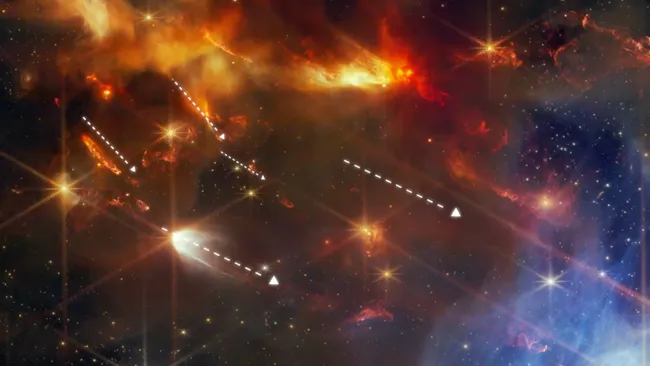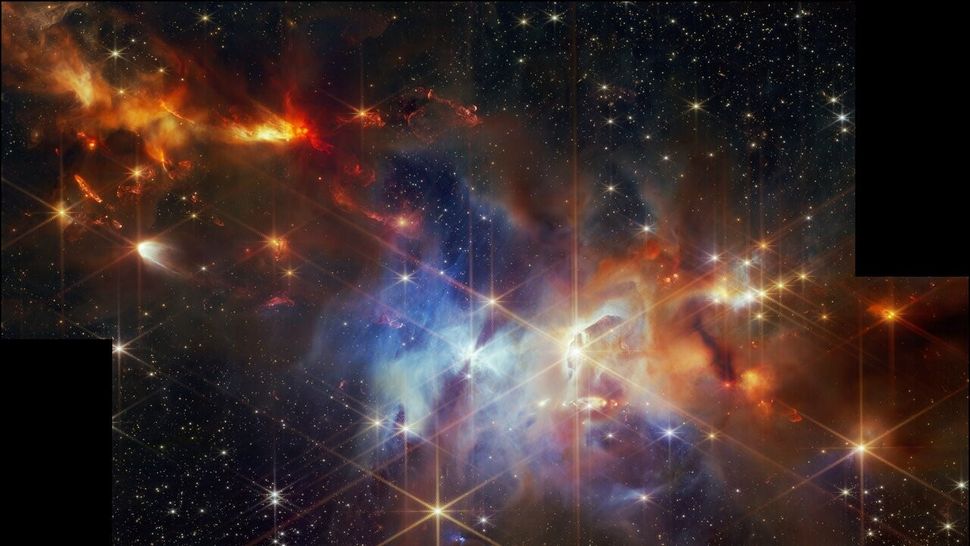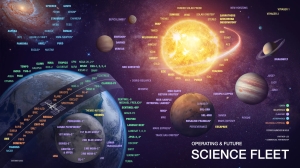
James Webb Infrared Space Telescope annotated, finally launched December 25, 2021, ten years late. Click for more readable view.
And
At
The California Institute of Technology
Via
6.21.24
Brandon Specktor
Webb has spotted a peculiar group of baby stars firing enormous jets into space at nearly the exact same angle. The discovery could hold new insights into how stars are born.

A close-up image showing five of the protostellar outflows in Serpens Main, all angled in the same direction. The outflows appear as bright orange blobs. (Image credit: Klaus Pontoppidan (NASA-JPL), Joel Green (STScI))
Astronomers using Webb have observed a strange stellar phenomenon for the first time ever: A group of baby stars painting the walls of their nursery in seemingly coordinated jets of high-speed gas. And strangely, they are all pointing in the same direction.
This messy discovery presents the first direct image of a long-studied phenomenon called “protostellar outflows” — huge jets of gas released by newborn stars, which collide with and charge material in the molecular gas clouds that surround them. But it also reveals a baffling new mystery: Why do many of the newly discovered jets appear to be aligned in the exact same direction, despite coming from widely separated stars?
The observations, described in a new study in The Astrophysical Journal, could reveal crucial new information about how stars form, and how they evolve.
“Astronomers have long assumed that as clouds collapse to form stars, the stars will tend to spin in the same direction,” principal investigator Klaus Pontoppidan of NASA’s Jet Propulsion Laboratory said in a statement. “However, this has not been seen so directly before. These aligned, elongated structures are a historical record of the fundamental way that stars are born.”
The newly imaged baby stars share a nursery in the Serpens Main nebula — a vast and sinuous cloud of star-forming gas located in the Serpens constellation, roughly 1,300 light-years from Earth, according to NASA. Astronomers observed the nebula with JWST’s powerful Near-Infrared Camera (NIRCam) [below], taking note of the hot, ionized trails of gas pushing through the star-forming cloud.

Webb’s view of the Serpens Main nebula. In the upper left corner, orange streaks show strangely aligned outbursts from newborn stars. (Image credit: K. Pontoppidan (NASA’s Jet Propulsion Laboratory) and J. Green (Space Telescope Science Institute))
The observations revealed at least 20 newborn stars in the region that were actively emitting protostellar outflows. One group of 12 stars (seen in the upper left corner of the JWST image) caught the team’s attention. The jets blazing from these stars were all oriented in almost the exact same direction, “like sleet pouring down during a storm,” according to the NASA statement. The team estimated that the outflows are relatively young, beginning between 200 to 1,400 years ago.
Such perfectly-aligned outflows have never been seen before, and are highly unlikely to be the result of random chance. According to the researchers, it’s likely that the group of 12 jet-spouting stars formed around the same time as each other, and along the same dense filament of gas. A powerful magnetic field defines the boundaries of this star-forming filament, and may also be responsible for directing the angle of the protostellar jets seen spewing there. Over time, this effect weakens as interactions with other objects slightly sway the spin axes of individual stars, redirecting the jets. This drift over time could explain why astronomers have never seen such perfect alignments before.
Further study of these coordinated outflows could reveal new details about how stars are born. Next, researchers plan to study Serpens Main with Webb’s Near-Infrared Spectrograph (NIRSpec) instrument [below] to better understand the chemical composition of the vast star nursery — which could reveal how solar systems like our own transfer elements from stars to young planets.
See the full article here .
Comments are invited and will be appreciated, especially if the reader finds any errors which I can correct.
five-ways-keep-your-child-safe-school-shootings
Please help promote STEM in your local schools.

NASA’s Jet Propulsion Laboratory (JPL) is a federally funded research and development center in Pasadena. Founded in 1936 by Caltech researchers, the laboratory is now owned and sponsored by the National Aeronautics and Space Administration (NASA) and administered and managed by the California Institute of Technology.
The laboratory’s primary function is the construction and operation of planetary robotic spacecraft, though it also conducts Earth-orbit and astronomy missions. It is also responsible for operating the NASA Deep Space Network.
Among the laboratory’s major active projects are the Mars 2020 mission, which includes the Perseverance rover; the Mars Science Laboratory mission, including the Curiosity rover; the Mars Reconnaissance Orbiter; the Juno spacecraft orbiting Jupiter; the SMAP satellite for earth surface soil moisture monitoring; the NuSTAR X-ray telescope; and the Psyche asteroid orbiter.








It is also responsible for managing the JPL Small-Body Database, and provides physical data and lists of publications for all known small Solar System bodies.
JPL’s Space Flight Operations Facility and Twenty-Five-Foot Space Simulator are designated National Historic Landmarks.







The National Aeronautics and Space Administration (NASA) is the agency of the United States government that is responsible for the nation’s civilian space program and for aeronautics and aerospace research.
President Dwight D. Eisenhower established the National Aeronautics and Space Administration (NASA) in 1958 with a distinctly civilian (rather than military) orientation encouraging peaceful applications in space science. The National Aeronautics and Space Act was passed on July 29, 1958, disestablishing NASA’s predecessor, the National Advisory Committee for Aeronautics (NACA). The new agency became operational on October 1, 1958.
Since that time, most U.S. space exploration efforts have been led by NASA, including the Apollo moon-landing missions, the Skylab space station, and later the Space Shuttle.
Currently, NASA is supporting the International Space Station and is overseeing the development of the Orion Multi-Purpose Crew Vehicle and Commercial Crew vehicles.
The agency is also responsible for the Launch Services Program (LSP) which provides oversight of launch operations and countdown management for unmanned NASA launches. Most recently, NASA announced a new Space Launch System that it said would take the agency’s astronauts farther into space than ever before and lay the cornerstone for future human space exploration efforts by the U.S.

NASA science is focused on better understanding Earth through the Earth Observing System, advancing heliophysics through the efforts of the Science Mission Directorate’s Heliophysics Research Program, exploring bodies throughout the Solar System with advanced robotic missions such as
New Horizons, and researching astrophysics topics, such as the Big Bang, through the Great Observatories [Hubble, Chandra, Spitzer, and associated programs.]




NASA shares data with various national and international organizations such as from the[JAXA] Greenhouse Gases Observing Satellite.
Webb is a large infrared telescope with a 6.5-meter primary mirror. Webb was finally launched December 25, 2021, ten years late. Webb will be the premier observatory of the next decade, serving thousands of astronomers worldwide. It will study every phase in the history of our Universe, ranging from the first luminous glows after the Big Bang, to the formation of solar systems capable of supporting life on planets like Earth, to the evolution of our own Solar System.
Webb is the world’s largest, most powerful, and most complex space science telescope ever built. Webb will solve mysteries in our solar system, look beyond to distant worlds around other stars, and probe the mysterious structures and origins of our universe and our place in it.
Webb was formerly known as the “Next Generation Space Telescope” (NGST); it was renamed in Sept. 2002 after a former NASA administrator, James Webb.
Webb is an international collaboration between National Aeronautics and Space Administration, the European Space Agency (ESA), and the Canadian Space Agency (CSA). The NASA Goddard Space Flight Center managed the development effort. The main industrial partner is Northrop Grumman; the Space Telescope Science Institute operates Webb.
Several innovative technologies have been developed for Webb. These include a folding, segmented primary mirror, adjusted to shape after launch; ultra-lightweight beryllium optics; detectors able to record extremely weak signals, microshutters that enable programmable object selection for the spectrograph; and a cryocooler for cooling the mid-IR detectors to 7K.
There are four science instruments on Webb: The Near InfraRed Camera (NIRCam), The Near InfraRed Spectrograph (NIRspec), The Mid-InfraRed Instrument (MIRI), and The Fine Guidance Sensor/ Near InfraRed Imager and Slitless Spectrograph (FGS-NIRISS).
Webb’s instruments are designed to work primarily in the infrared range of the electromagnetic spectrum, with some capability in the visible range. It will be sensitive to light from 0.6 to 28 micrometers in wavelength.




Webb has four main science themes: The End of the Dark Ages: First Light and Reionization, The Assembly of Galaxies, The Birth of Stars and Protoplanetary Systems, and Planetary Systems and the Origins of Life.
Launch was December 25, 2021, ten years late, on an Ariane 5 rocket. The launch was from Arianespace’s ELA-3 launch complex at European Spaceport located near Kourou, French Guiana. Webb is located at the second Lagrange point, about a million miles from the Earth.











